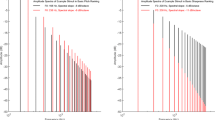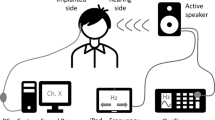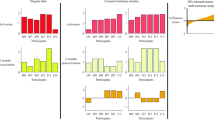Abstract
By allowing bilateral access to sound, bilateral cochlear implants (BI-CIs) or unilateral CIs for individuals with single-sided deafness (SSD; i.e., normal or near-normal hearing in one ear) can improve sound localization and speech understanding in noise. Spatial hearing in the horizontal plane is primarily conveyed by interaural time and level differences computed from neurons in the superior olivary complex that receive frequency-matched inputs. Because BI-CIs and SSD-CIs do not necessarily convey frequency-matched information, it is critical to understand how to align the inputs to CI users. Previous studies show that interaural pitch discrimination for SSD-CI listeners is highly susceptible to contextual biases, questioning its utility for establishing interaural frequency alignment. Here, we replicate this finding for SSD-CI listeners and show that these biases also extend to BI-CI listeners. To assess the testing-range bias, three ranges of comparison electrodes (BI-CI) or pure-tone frequencies (SSD-CI) were tested: full range, apical/lower half, or basal/upper half. To assess the reference bias, the reference electrode was either held fixed throughout a testing block or randomly chosen from three electrodes (basal end, middle, or apical end of the array). Results showed no effect of reference electrode randomization, but a large testing range bias; changing the center of the testing-range shifted the pitch match by an average 63 % (BI-CI) or 43 % (SSD-CI) of the change magnitude. This bias diminished pitch-match accuracy, with a change in reference electrode shifting the pitch match only an average 34 % (BI-CI) or 40 % (SSD-CI) of the expected amount. Because these effects extended to the relatively more symmetric BI-CI listeners, the results suggest that the bias cannot be attributed to interaural asymmetry. Unless the range effect can be minimized or accounted for, a pitch-discrimination task will produce interaural place-of-stimulation estimates that are highly influenced by the conditions tested, rather than reflecting a true interaural place-pitch comparison.





Similar content being viewed by others
Notes
We performed pilot tests using a very low rate, 25 pps, for several BI-CI listeners, because Carlyon et al. (2010) suggested that 25 pps might yield less biased results than 1000 pps. The main reason for using very low-rate pulse trains around 25 pps is to reduce the influence of temporal pitch cues on the pitch perception, because some electrodes have a different upper limit of temporal pitch than others (e.g., Kong and Carlyon 2010). We found no apparent difference in using 25 or 1000 pps in our pilot tests for listeners who could perform the task. For a few of our BI-CI listeners, the low rate was so distracting that they had substantial difficulty or could not perform the interaural pitch-discrimination task. Changing to the higher rate allowed them to better attend to the pitch of the pulse train. We therefore opted for the higher stimulation rate for this study. Note, that this finding is in contrast to other studies where BI-CI listeners appeared to have no problem with interaural pitch discrimination using 25-pps pulse trains (e.g., Ihlefeld et al. 2015). The reason for the discrepancy is unclear and motivates further investigation on the use of very low rates in interaural pitch-discrimination tasks.
The Latin square design applied to listeners BCI1, 2, 4, 5, 6 and 7. We recruited one extra BI-CI listener for the study, BCI3, who was tested on the same order of conditions as listener BCI5. Listener BCI6, who was tested with the reference electrodes in both the right and left ears, was assigned a unique order for the left ear, but the same order as BCI1 for the right ear.
References
Adunka OF, Pillsbury HC, Kiefer J (2006) Combining perimodiolar electrode placement and atraumatic insertion properties in cochlear implantation—fact or fantasy? Acta Otolaryngol 126:475–482
Aronoff JM, Padilla M, Stelmach J, Landsberger DM (2016) Clinically paired electrodes are often not perceived as pitch matched. Trends Hear 20:2331216516668302
Baumann U, Nobbe A (2004) Pitch ranking with deeply inserted electrode arrays. Ear Hear 25:275–283
Bernstein JGW, Stakhovskaya OA, Schuchman GI, Jensen KK, Goupell MJ (2018) Interaural-time-difference discrimination as a measure of place of stimulation for cochlear-implant users with single-sided deafness. Trends Hear 22:2331216518765514
Bierer JA, Nye AD (2014) Comparisons between detection threshold and loudness perception for individual cochlear implant channels. Ear Hear 35:641–651
Blanks DA, Roberts JM, Buss E, Hall JW, Fitzpatrick DC (2007) Neural and behavioral sensitivity to interaural time differences using amplitude modulated tones with mismatched carrier frequencies. J Assoc Res Otolaryngol 8:393–408
Carlyon RP, Macherey O, Frijns JH, Axon PR, Kalkman RK, Boyle P, Baguley DM, Briggs J, Deeks JM, Briaire JJ, Barreau X, Dauman R (2010) Pitch comparisons between electrical stimulation of a cochlear implant and acoustic stimuli presented to a normal-hearing contralateral ear. J Assoc Res Otolaryngol 11:625–640
Carr CE, Konishi M (1990) A circuit for detection of interaural time differences in the brain stem of the barn owl. J Neurosci 10:3227–3246
Chatterjee M, Yu J (2010) A relation between electrode discrimination and amplitude modulation detection by cochlear implant listeners. J Acoust Soc Am 127:415–426
Francart T, Brokx J, Wouters J (2008) Sensitivity to interaural time differences with combined cochlear implant and acoustic stimulation. J Assoc Res Otolaryngol 10:131–141
Goupell MJ (2015) Interaural correlation-change discrimination in bilateral cochlear-implant users: effects of interaural frequency mismatch, centering, and age of onset of deafness. J Acoust Soc Am 137:1282–1297
Goupell MJ, Litovsky RY (2015) Detection of changes in envelope correlation in bilateral cochlear-implant users. J Acoust Soc Am 137:335–349
Greenwood DD (1990) A cochlear frequency-position function for several species—29 years later. J Acoust Soc Am 87:2592–2605
Hu H, Dietz M (2015) Comparison of interaural electrode pairing methods for bilateral cochlear implants. Trends Hear 2331216515617143
Ihlefeld A, Carlyon RP, Kan A, Churchill TH, Litovsky RY (2015) Limitations on monaural and binaural temporal processing in bilateral cochlear implant listeners. J Assoc Res Otolaryngol 16:641–652
Joris PX, Smith PH, Yin TC (1998) Coincidence detection in the auditory system: 50 years after Jeffress. Neuron 21:1235–1238
Kan A, Stoelb C, Litovsky RY, Goupell MJ (2013) Effect of mismatched place-of-stimulation on binaural fusion and lateralization in bilateral cochlear-implant users. J Acoust Soc Am 134:2923–2936
Kan A, Litovsky RY, Goupell MJ (2015) Effects of interaural pitch-matching and auditory image centering on binaural sensitivity in cochlear-implant users. Ear Hear 36:e62–e68
Kong YY, Carlyon RP (2010) Temporal pitch perception at high rates in cochlear implants. J Acoust Soc Am 127:3114–3123
Landsberger DM, Svrakic M, Roland JT Jr, Svirsky M (2015) The relationship between insertion angles, default frequency allocations, and spiral ganglion place pitch in cochlear implants. Ear Hear 36:e207–e213
Litovsky RY, Jones GL, Agrawal S, van Hoesel R (2010) Effect of age at onset of deafness on binaural sensitivity in electric hearing in humans. J Acoust Soc Am 127:400–414
Litovsky RY, Goupell MJ, Kan A, Landsberger DM (2017) Use of research interfaces for psychophysical studies with cochlear-implant users. Trends Hear 21:2331216517736464
Long CJ, Nimmo-Smith I, Baguley DM, O'Driscoll M, Ramsden R, Otto SR, Axon PR, Carlyon RP (2005) Optimizing the clinical fit of auditory brain stem implants. Ear Hear 26:251–262
Lu T, Litovsky R, Zeng FG (2011) Binaural unmasking with multiple adjacent masking electrodes in bilateral cochlear implant users. J Acoust Soc Am 129:3934–3945
McKay CM, O'Brien A, James CJ (1999) Effect of current level on electrode discrimination in electrical stimulation. Hear Res 136:159–164
Noel VA, Eddington DK (2013) Sensitivity of bilateral cochlear implant users to fine-structure and envelope interaural time differences. J Acoust Soc Am 133:2314–2328
Poulton EC (1979) Models for biases in judging sensory magnitude. Psychol Bull 86:777–803
Radeloff A, Mack M, Baghi M, Gstoettner WK, Adunka OF (2008) Variance of angular insertion depths in free-fitting and perimodiolar cochlear implant electrodes. Otol Neurotol 29:131–136
Reiss LA, Turner CW, Erenberg SR, Gantz BJ (2007) Changes in pitch with a cochlear implant over time. J Assoc Res Otolaryngol 8:241–257
Reiss LA, Turner CW, Karsten SA, Gantz BJ (2014) Plasticity in human pitch perception induced by tonotopically mismatched electro-acoustic stimulation. Neuroscience 256:43–52
Reiss LA, Ito RA, Eggleston JL, Liao S, Becker JJ, Lakin CE, Warren FM, McMenomey SO (2015) Pitch adaptation patterns in bimodal cochlear implant users: over time and after experience. Ear Hear 36:e23–e34
Schatzer R, Vermeire K, Visser D, Krenmayr A, Kals M, Voormolen M, Van de Heyning P, Zierhofer C (2014) Electric-acoustic pitch comparisons in single-sided-deaf cochlear implant users: frequency-place functions and rate pitch. Hear Res 309:26–35
Studebaker GA (1985) A ‘rationalized’ arcsine transform. J Speech Hear Res 28:455–462
Tan CT, Martin B, Svirsky MA (2017) Pitch matching between electrical stimulation of a cochlear implant and acoustic stimuli presented to a contralateral ear with residual hearing. J Am Acad Audiol 28:187–199
van der Marel KS, Briaire JJ, Wolterbeek R, Snel-Bongers J, Verbist BM, Frijns JH (2014) Diversity in cochlear morphology and its influence on cochlear implant electrode position. Ear Hear 35:e9–e20
van Hoesel RJM, Jones GL, Litovsky RY (2009) Interaural time-delay sensitivity in bilateral cochlear implant users: effects of pulse rate, modulation rate, and place of stimulation. J Assoc Res Otolaryngol 10:557–567
Vermeire K, Nobbe A, Schleich P, Nopp P, Voormolen MH, Van de Heyning PH (2008) Neural tonotopy in cochlear implants: an evaluation in unilateral cochlear implant patients with unilateral deafness and tinnitus. Hear Res 245:98–106
Wess JM, Brungart DS, Bernstein JGW (2017) The effect of interaural mismatches on contralateral unmasking with single-sided vocoders. Ear Hear 38:374–386
Wichmann FA, Hill NJ (2001) The psychometric function: I. fitting, sampling, and goodness of fit. Percept Psychophys 63:1293–1313
Williges B, Jurgens T, Hu H, Dietz M (2018) Coherent coding of enhanced interaural cues improves sound localization in noise with bilateral cochlear implants. Trends Hear 22:2331216518781746
Yin TC, Chan JC (1990) Interaural time sensitivity in medial superior olive of cat. J Neurophysiol 64:465–488
Acknowledgements
We thank Cochlear Ltd. and Med-El for providing the testing equipment and technical support. We thank Danielle King, Emily Waddington, and Tori Levi who helped collect data for this study. We thank the Department of Hearing and Speech Sciences at University of Maryland, College Park (Dr. Nicole Nguyen), the Cochlear Implant Center at Greater Baltimore Medical Center (Dr. Regina Presley), the University of Maryland Medical School (Dr. David Eisenman and Dr. Ronna Hertzano), and Walter Reed National Military Medical Center (Dr. Gerald Schuchman) for their assistance with recruiting listeners. We thank Ginny Alexander for the managerial help and Kenneth Jensen for helpful comments on a previous version of this paper. The views expressed in this article are those of the authors and do not reflect the official policy of the Department of Army/Navy/Air Force, Department of Defense, or U.S. Government. The identification of specific products or scientific instrumentation does not constitute endorsement or implied endorsement on the part of the author, DoD, or any component agency.
Funding
The research reported in this publication was supported by the National Institute On Deafness And Other Communication Disorders of the National Institutes of Health under Award Number R01 DC015798 (M.J.G. and J.G.W.B.). The content is solely the responsibility of the authors and does not necessarily represent the official views of the National Institutes of Health.
Author information
Authors and Affiliations
Corresponding author
Ethics declarations
Conflict of Interest
The authors declare that they have no competing interests.
Additional information
Publisher’s Note
Springer Nature remains neutral with regard to jurisdictional claims in published maps and institutional affiliations.
Rights and permissions
About this article
Cite this article
Goupell, M.J., Cosentino, S., Stakhovskaya, O.A. et al. Interaural Pitch-Discrimination Range Effects for Bilateral and Single-Sided-Deafness Cochlear-Implant Users. JARO 20, 187–203 (2019). https://doi.org/10.1007/s10162-018-00707-x
Received:
Accepted:
Published:
Issue Date:
DOI: https://doi.org/10.1007/s10162-018-00707-x




